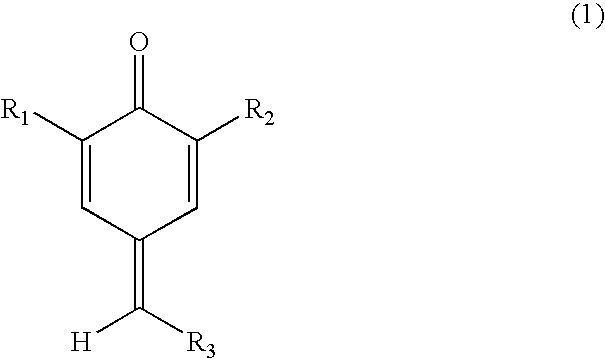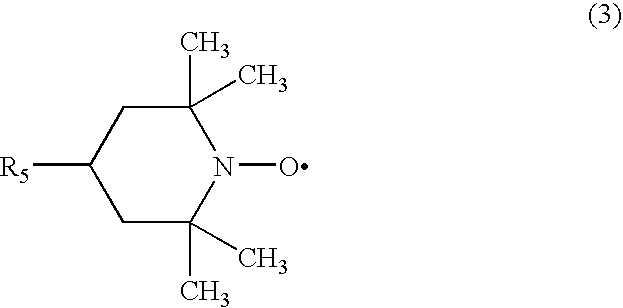Polymerization inhibitor for aromatic vinyl compounds and method for inhibiting the polymerization of the compounds
a technology of aromatic vinyl compound and polymerization inhibitor, which is applied in the field of polymerization inhibitor of aromatic vinyl compound, can solve the problems of forming fouling in petroleum refinery plant, troublesome operation of facilities, and lowering of monomeric aromatic vinyl compound yield, and achieves low toxicity, high polymerization inhibitory effect, and easy handling
- Summary
- Abstract
- Description
- Claims
- Application Information
AI Technical Summary
Benefits of technology
Problems solved by technology
Method used
Image
Examples
Embodiment Construction
[0033] The present invention is illustrated in more details by the working example but it is not restricted to the following working examples.
[0034] [Compounds Used for Evaluation]
(Quinone Methide Compound)
[0035] A-1: 2,6-di-tert-butyl-4-benzylidene-cyclohexa-2,5-dienone
[0036] 2,6-Di-tert-butyl-4-benzylidene-cyclohexa-2,5-dienone was synthesized according to the method described in “Synth.Commun.”
[0037] [B. Koutek et al.; 6 (4), 305 (1976)]. 2.1 Grams (10 mmol) of 2,6-di-tert-butyl phenol, 1.06 g (10 mmol) of benzaldehyde, 0.9 g (10.5 mmol of piperidine and 15 ml of n-butanol were placed in a 100 ml of eggplant type flask equipped with a Dimroth condenser and refluxed for 24 hours under an atmosphere of nitrogen. After the reflux, n-butanol was distilled out under reduced pressure and the reaction product was purified by silica gel column chromatography (a development solvent of n-hexane:methylene chloride=2:1) to obtain quinone methide compound (A-1).
[0038] A-2: 2,6-di-tert-bu...
PUM
| Property | Measurement | Unit |
|---|---|---|
| temperature | aaaaa | aaaaa |
| velocity | aaaaa | aaaaa |
| residence time | aaaaa | aaaaa |
Abstract
Description
Claims
Application Information
 Login to View More
Login to View More - R&D
- Intellectual Property
- Life Sciences
- Materials
- Tech Scout
- Unparalleled Data Quality
- Higher Quality Content
- 60% Fewer Hallucinations
Browse by: Latest US Patents, China's latest patents, Technical Efficacy Thesaurus, Application Domain, Technology Topic, Popular Technical Reports.
© 2025 PatSnap. All rights reserved.Legal|Privacy policy|Modern Slavery Act Transparency Statement|Sitemap|About US| Contact US: help@patsnap.com



